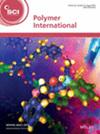求助PDF
{"title":"生物功能聚对苯二甲酸乙二醇酯表面CO2等离子体活化","authors":"Rohini Verma, Chetna Verma, Bhuvanesh Gupta, Samrat Mukhopadhyay","doi":"10.1002/pi.6756","DOIUrl":null,"url":null,"abstract":"<p>Polyethylene terephthalate (PET) fabric was functionalized by carbon dioxide (CO<sub>2</sub>) plasma treatment to introduce carboxyl (–COOH) functionality on its surface. The presence of hydrophilic groups increased the hydrophilicity and decreased the water drop absorption time as the plasma exposure time increased from 30 to 120 s. The maximum carboxyl content of 1.9 μg cm<sup>−2</sup> was achieved within 60 s exposure time, with 80 W discharge power and 40 cm<sup>3</sup> min<sup>−1</sup> gas flow rate. The surface chemistry of untreated and plasma-treated PET fabrics was analyzed using attenuated total reflectance - Fourier transform infrared spectroscopy (ATR-FTIR) and X-ray photoelectron spectroscopy (XPS). The surface morphology was monitored as a function of exposure time using field emission scanning electron microscopy (FE-SEM) and atomic force spectroscopy (AFM). The colony count method was used to study the <i>Escherichia coli</i> <i>(E. coli)</i> and <i>Staphylococcus aureus</i> <i>(S. aureus)</i> bacterial adhesion on the surface. Polyethylene glycol (PEG) (molecular weight 1000) was used to immobilize the plasma-treated surface. The results showed a significant reduction in the bacterial adhesion to the functionalized PET fabric compared to untreated fabric. However, the immobilization of PEG on the PET surface inhibited bacterial adherence significantly and imparted antifouling behavior on the fabric surface. © 2025 Society of Chemical Industry.</p>","PeriodicalId":20404,"journal":{"name":"Polymer International","volume":"74 8","pages":"657-666"},"PeriodicalIF":3.6000,"publicationDate":"2025-04-10","publicationTypes":"Journal Article","fieldsOfStudy":null,"isOpenAccess":false,"openAccessPdf":"","citationCount":"0","resultStr":"{\"title\":\"Biofunctional polyethylene terephthalate surface by CO2 plasma activation\",\"authors\":\"Rohini Verma, Chetna Verma, Bhuvanesh Gupta, Samrat Mukhopadhyay\",\"doi\":\"10.1002/pi.6756\",\"DOIUrl\":null,\"url\":null,\"abstract\":\"<p>Polyethylene terephthalate (PET) fabric was functionalized by carbon dioxide (CO<sub>2</sub>) plasma treatment to introduce carboxyl (–COOH) functionality on its surface. The presence of hydrophilic groups increased the hydrophilicity and decreased the water drop absorption time as the plasma exposure time increased from 30 to 120 s. The maximum carboxyl content of 1.9 μg cm<sup>−2</sup> was achieved within 60 s exposure time, with 80 W discharge power and 40 cm<sup>3</sup> min<sup>−1</sup> gas flow rate. The surface chemistry of untreated and plasma-treated PET fabrics was analyzed using attenuated total reflectance - Fourier transform infrared spectroscopy (ATR-FTIR) and X-ray photoelectron spectroscopy (XPS). The surface morphology was monitored as a function of exposure time using field emission scanning electron microscopy (FE-SEM) and atomic force spectroscopy (AFM). The colony count method was used to study the <i>Escherichia coli</i> <i>(E. coli)</i> and <i>Staphylococcus aureus</i> <i>(S. aureus)</i> bacterial adhesion on the surface. Polyethylene glycol (PEG) (molecular weight 1000) was used to immobilize the plasma-treated surface. The results showed a significant reduction in the bacterial adhesion to the functionalized PET fabric compared to untreated fabric. However, the immobilization of PEG on the PET surface inhibited bacterial adherence significantly and imparted antifouling behavior on the fabric surface. © 2025 Society of Chemical Industry.</p>\",\"PeriodicalId\":20404,\"journal\":{\"name\":\"Polymer International\",\"volume\":\"74 8\",\"pages\":\"657-666\"},\"PeriodicalIF\":3.6000,\"publicationDate\":\"2025-04-10\",\"publicationTypes\":\"Journal Article\",\"fieldsOfStudy\":null,\"isOpenAccess\":false,\"openAccessPdf\":\"\",\"citationCount\":\"0\",\"resultStr\":null,\"platform\":\"Semanticscholar\",\"paperid\":null,\"PeriodicalName\":\"Polymer International\",\"FirstCategoryId\":\"92\",\"ListUrlMain\":\"https://scijournals.onlinelibrary.wiley.com/doi/10.1002/pi.6756\",\"RegionNum\":4,\"RegionCategory\":\"化学\",\"ArticlePicture\":[],\"TitleCN\":null,\"AbstractTextCN\":null,\"PMCID\":null,\"EPubDate\":\"\",\"PubModel\":\"\",\"JCR\":\"Q2\",\"JCRName\":\"POLYMER SCIENCE\",\"Score\":null,\"Total\":0}","platform":"Semanticscholar","paperid":null,"PeriodicalName":"Polymer International","FirstCategoryId":"92","ListUrlMain":"https://scijournals.onlinelibrary.wiley.com/doi/10.1002/pi.6756","RegionNum":4,"RegionCategory":"化学","ArticlePicture":[],"TitleCN":null,"AbstractTextCN":null,"PMCID":null,"EPubDate":"","PubModel":"","JCR":"Q2","JCRName":"POLYMER SCIENCE","Score":null,"Total":0}
引用次数: 0
引用
批量引用





 求助内容:
求助内容: 应助结果提醒方式:
应助结果提醒方式:


